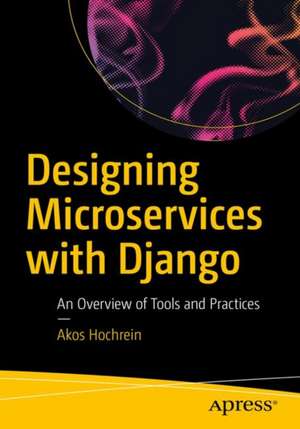Designing Microservices with Django: An Overview of Tools and Practices
Autor Akos Hochreinen Limba Engleză Paperback – 29 noi 2019
Explore microservices using the Python-based Django framework and review the benefits and drawbacks of them. This book will examine what microservices look like, how they talk to each other, and how they are crafted using the Python programming language and the Django web framework.
You’ll start by understanding what the key differences are between microservices and monolithic architectures. The book then does a deep dive into how microservices are built and what common models have emerged in our industry. You’ll also take an extensive look at communication and ownership patterns and examine methodologies to speed up your architecture evolution by writing less but more distributed code using the Python programming language and the Django web framework.
By the end of the book, you’ll have a solid understanding of microservices architectures. Armed with a comprehensive and solid toolset, you can begin working toward systems that are more scalable, resilient, and maintainable.
What You’ll Learn
You’ll start by understanding what the key differences are between microservices and monolithic architectures. The book then does a deep dive into how microservices are built and what common models have emerged in our industry. You’ll also take an extensive look at communication and ownership patterns and examine methodologies to speed up your architecture evolution by writing less but more distributed code using the Python programming language and the Django web framework.
By the end of the book, you’ll have a solid understanding of microservices architectures. Armed with a comprehensive and solid toolset, you can begin working toward systems that are more scalable, resilient, and maintainable.
What You’ll Learn
- Understand the benefits and drawbacks of adopting microservices
- Design systems and architecture for resiliency and distributed ownership
- Work with tools for scaling distributed system both in technical and organizational dimensions
- Examine the essentials of the Django web framework
Preț: 251.76 lei
Preț vechi: 314.70 lei
-20% Nou
Puncte Express: 378
Preț estimativ în valută:
48.18€ • 49.100$ • 40.27£
48.18€ • 49.100$ • 40.27£
Carte disponibilă
Livrare economică 22 februarie-08 martie
Preluare comenzi: 021 569.72.76
Specificații
ISBN-13: 9781484253571
ISBN-10: 1484253574
Pagini: 166
Ilustrații: XV, 166 p. 22 illus.
Dimensiuni: 155 x 235 x 10 mm
Greutate: 0.27 kg
Ediția:1st ed.
Editura: Apress
Colecția Apress
Locul publicării:Berkeley, CA, United States
ISBN-10: 1484253574
Pagini: 166
Ilustrații: XV, 166 p. 22 illus.
Dimensiuni: 155 x 235 x 10 mm
Greutate: 0.27 kg
Ediția:1st ed.
Editura: Apress
Colecția Apress
Locul publicării:Berkeley, CA, United States
Cuprins
Chapter 1. What are Services?.- Chapter 2. A Pinch of Django.- Chapter 3. Anatomy of a Microservice.- Chapter 4. Communication.- Chapter 5. From Monolith to Microservice.- Chapter 6. Scaling Development.
Notă biografică
Akos Hochrein is a software engineer and technical lead. After receiving his degree in computer science, he started his career as a consultant and soon became a product developer at a well-known Hungarian startup, later moving to Berlin to dive into the local tech scene and to broaden his backend architecture design experience. Throughout his career he worked in areas like frontend and backend development, integrations, data streaming and systems design. Occasionally, he shares his knowledge on various forums, such as technical conferences, his blog … or a book.
Textul de pe ultima copertă
Explore microservices using Python-based Django framework and review the benefits and drawbacks of them. This book will examine what microservices look like, how they talk to each other, and how they are crafted using the Python programming language and the Django web framework.
You’ll start by understanding what the key differences are between microservices and monolithic architectures. The book then does a deep dive into how microservices are built and what common models have emerged in our industry. You’ll also take an extensive look at communication and ownership patterns and examine methodologies to speed up your architecture evolution by writing less but more distributed code using the Python programming language and the Django web framework.
By the end, you’ll have a solid understanding of microservices architectures. Armed with a comprehensive and solid toolset, you can begin working toward systems that are more scalable, resilient, and maintainable.
What You’ll Learn
You’ll start by understanding what the key differences are between microservices and monolithic architectures. The book then does a deep dive into how microservices are built and what common models have emerged in our industry. You’ll also take an extensive look at communication and ownership patterns and examine methodologies to speed up your architecture evolution by writing less but more distributed code using the Python programming language and the Django web framework.
By the end, you’ll have a solid understanding of microservices architectures. Armed with a comprehensive and solid toolset, you can begin working toward systems that are more scalable, resilient, and maintainable.
What You’ll Learn
- Understand the benefits and drawbacks of adopting microservices
- Design systems and architecture for resiliency and distributed ownership
- Work with tools for scaling distributed system both in technical and organizational dimensions
- Examine the essentials of the Django web framework
Caracteristici
The only book that covers Django for building microservices Hands on examples on how to design and build different type of microservices Understanding methods of migrating your monolith into a distributed system
